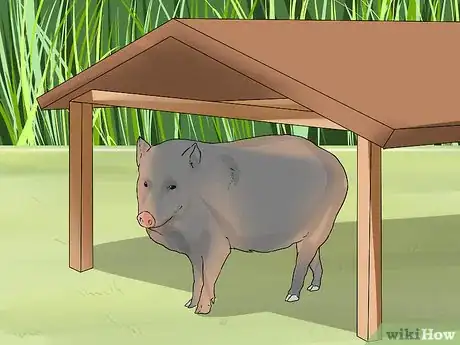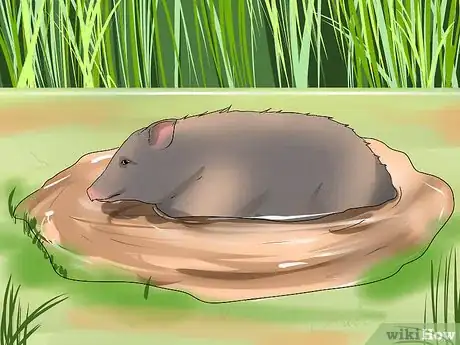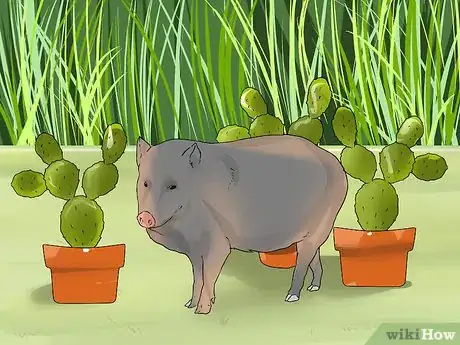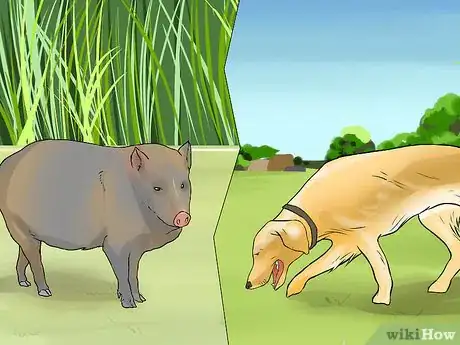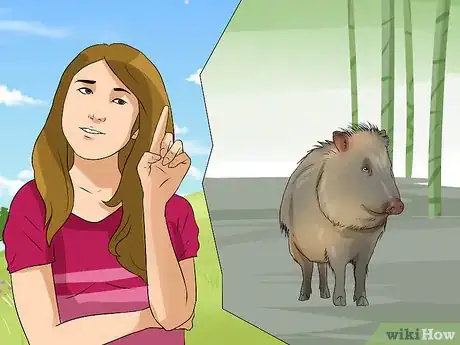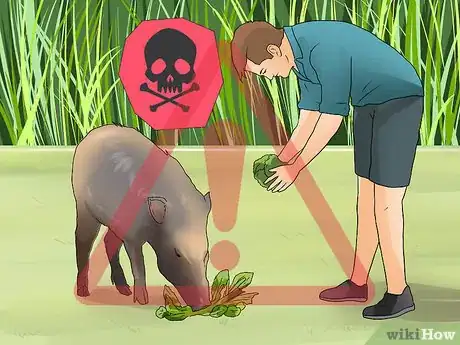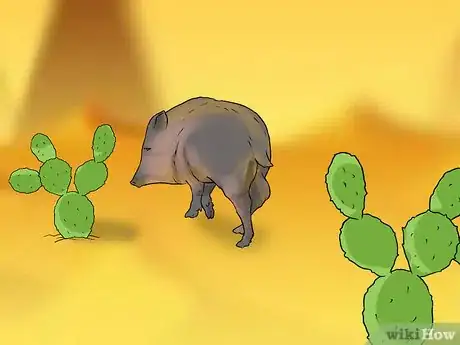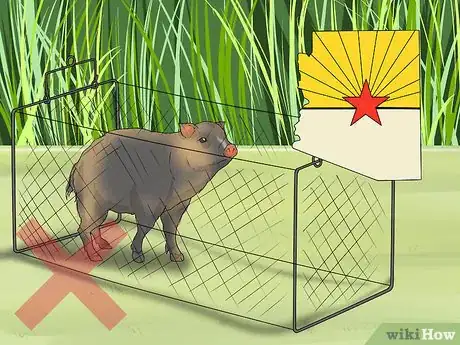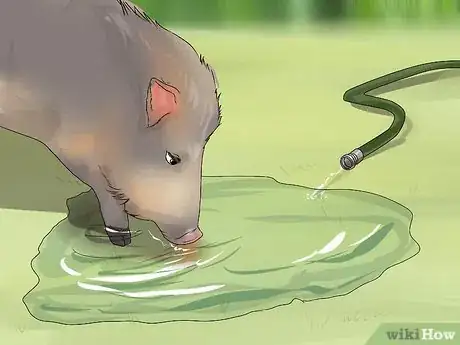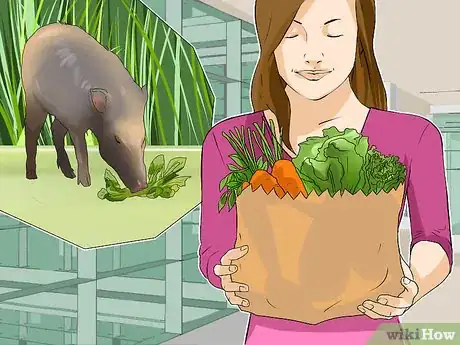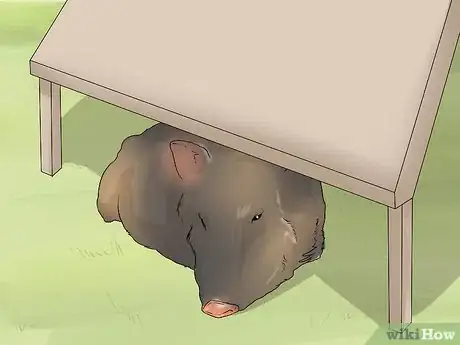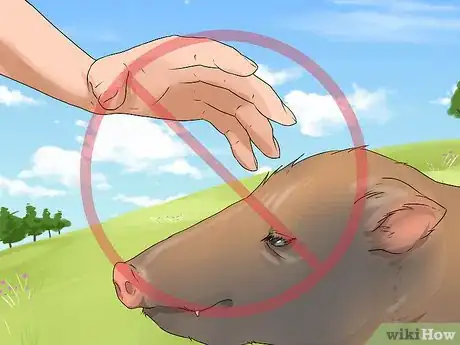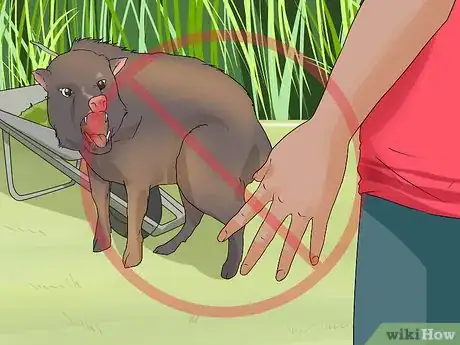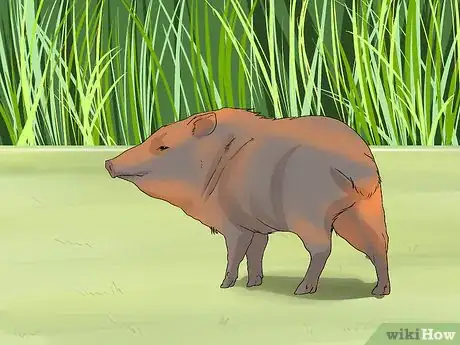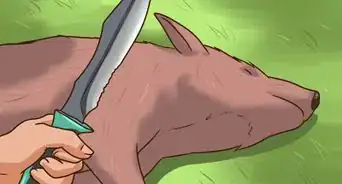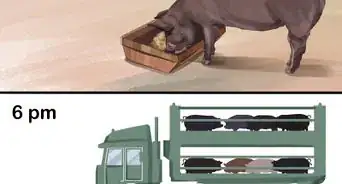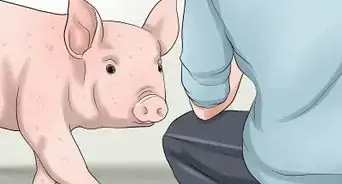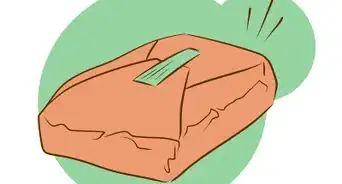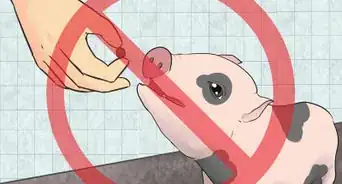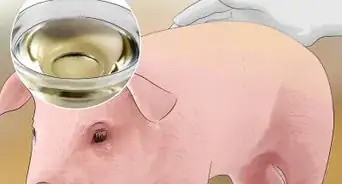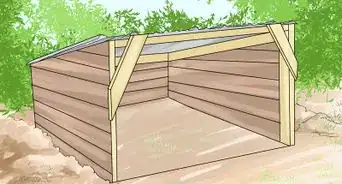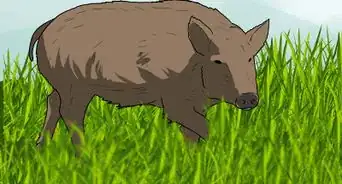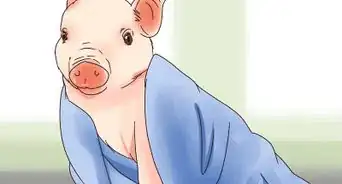This article was co-authored by wikiHow Staff. Our trained team of editors and researchers validate articles for accuracy and comprehensiveness. wikiHow's Content Management Team carefully monitors the work from our editorial staff to ensure that each article is backed by trusted research and meets our high quality standards.
This article has been viewed 32,333 times.
Learn more...
A Javelina, skunk pig, or peccary is a medium-sized hoofed mammal of the family Tayassuidae. The Javelina lives in hot desert climates and mainly eats cacti, prickly pear cactus, roots, insects, grubs, and seeds.[1] Read on if you'd like to find out how to take care of one, but be warned: the Javelina is a wild animal and can become aggressive. Authorities warn people not to feed or otherwise encourage contact with javelina.
Steps
Getting Ready for a Javelina
-
1Make sure you have shaded outdoor spots. Since the javelina, also known as the peccary or skunk pig, is similar to a pig (but is classified in an entirely different family, called the Tayassuidae family), it doesn’t cool down by sweating. It has to be in the shade during warm weather in order to stay cool.[2]
- You can provide shady spots with a porch, large trees, open air sheds, and other outdoor coverings.
-
2Set up watering places. Javelinas also need a steady source of water in order to survive. Offering a place where they can drink at any time of day or night is an important part of their habitat. It is useful if you have a pond, because they also like to roll around in wet mud to stay cool.[3]
- You can also fill up a kiddie pool to provide water, or allow the javelina to chew on an irrigation hose.
Advertisement -
3Install or maintain cacti in your yard. Prickly pear cactus plants are a favorite in the javelina’s wild habitat. The javelina is a native desert mammal, and prickly pear cacti are useful to them as food and shade sources. They are more comfortable when they are surrounded by cacti since this reminds them of home.[4]
- You can plant a “pad” of prickly pear cactus plants, and each one grows several brightly colored flowers in spring and summer. The flowers turn into edible fruits. It will grow best in the desert, but is not picky, so can be grown in most locations.[5]
-
4Make sure you have access to the right food. Javelinas like to eat things that they can forage for in the desert. They are mainly herbivores, meaning that they prefer to eat vegetation, although they have been known to eat lizards and dead rodents. Their preferred diet includes things like roots, nuts, beans, berries, grass, and cacti, especially agave.[6]
- They will also nose through human trash for food.
- You can easily provide these food items by using any fruit or nut trees on your property, or by purchasing them from the grocery store in bulk.
-
5Keep pets separate from them. The natural predators of javelinas are coyotes and dogs, so you must certainly keep your dogs away from javelinas, or they will become frightened, which can make them behave with aggression. It is wise to also keep cats and other pets out of the javelina’s way because it tends to become aggressive if it feels cornered or smells a dog.[7]
- Javelina also carry distemper, which easily passes to pets through the air.
-
6Talk to your family about the risks of caring for a javelina. Javelinas are wild animals and should be regarded with respect. They are not usually seen as pets, and since they are not bred by humans, you usually will not be able to find them at a pet store or for sale by neighbors. Javelinas can be dangerous because they have tusks, will bite, and carry diseases.
- They can carry salmonella and can catch distemper and rabies.
- They become aggressive if cornered, smell a dog, or if you get close to their babies.
Deciding to Take Care of a Javelina
-
1Recognize that a javelina is a wild animal. Javelinas are not usually made into pets. They are wild animals often on the list of prey targeted by local hunters, mainly because they can become pests because of their penchant for nosing through trash. Like wild deer, people do choose to feed them and interact with them, but authorities actually warn against doing this.
-
2Be aware that feeding a javelina can lead to its death. Javelinas can die after being fed by humans because they lose their fear of humans. Although people who care for javelinas usually do feed them, this is never advised because their frequent visits can cause problems in neighborhoods, leading to the death of the javelina either by irritated local hunters or by their subsequent proximity to coyotes and dogs.[8]
-
3Understand that the safest thing is to leave a javelina alone. Even though you may want to care for a javelina, the safest thing for both you and the javelina is to leave it alone. You may see some in your neighborhood or on your property if you live in desert areas of the U.S. like Arizona, New Mexico, and Texas, or in Mexico all the way down through Argentina, but if you feed them, they will start visiting your property, leading to a host of problems.[9]
- These problems include making them pests in your neighborhood, opening them up to threats of coyotes (which tend live near humans because they scavenge for food), risking getting diseases like salmonella and rabies, and risking getting bitten or jabbed by tusks yourself.
-
4Be warned that it is illegal to trap a javelina in Arizona. Javelinas live in desert areas, including those found in the U.S. state of Arizona. In this state, there is a law against trapping javelinas. Since the only way to come in contact with a javelina is by finding them in the wild, your only option for caring for a javelina is to offer to feed them, which is warned against by most government safety agencies.[10]
Meeting a Javelina’s Needs
-
1Provide a steady source of water. If you do decide to offer a habitat that a javelina would be comfortable in and a javelina does start visiting your property, you will need to sustain a source of clean drinking water. If you have a pond, you probably don’t need to think about it very much, but if not, a kiddie pool full of water will do.
- Check this pool every few days to make sure that the water is clean and full. You may have to periodically empty the pool and add fresh water to prevent algae from growing, or mosquitoes and flies from laying their eggs in it. (Both insects like still water.)
- You can also let the javelina chew on an irrigation hose.
-
2Provide it with the food it likes. Purchase or grow the food necessary to sustain a javelina, and keep this food available to them so that they don’t start going through your trash. They are good at foraging for food like roots, and you can provide seeds, beans, and green vegetation.
- If you can find them, you can grow agave plants and prickly pear cacti on your property to provide easy access to food for the javelina.
-
3Make sure you continue to have shady spots. Javelina can’t cool down on their own, so they prefer to rest in shady spots during the heat of the day. Make sure any trees, shrubbery, and shelter structures like porches and open sheds remain in place and in good repair.
-
4Avoid bringing the javelina indoors. Javelinas area wild animals, and bringing them inside a home or barn is a very bad idea. Javelinas are usually docile, especially when alone, but will become aggressive if they feel cornered. They will bite and have tusks, so it is easy for them to harm humans. The enclosed spaces of houses can easily trigger their instinct to fight.
- Instead, let them roam around outside.
-
5Avoid touching the javelina. Javelina are known for picking up diseases like rabies, salmonella, and distemper, all of which can be passed to humans either through touch or bite. To keep you and your family safe, avoid coming in contact with the javelina. Let it run around in your yard rather than becoming a cuddle pet like a dog or cat.[11]
-
6Avoid cornering or making the javelina feel trapped. Keeping the javelina outdoors is a good way to keep it from feeling trapped, but you should also avoid making it feel trapped when it is outside. Don’t try to push it in any direction, use any sort of device to lead it to a specific place, and don’t close a gate when it is inside an enclosed area.
- When a javelina feels trapped, it will try to defend itself by biting and attacking with its tusks.
-
7Make sure the javelina is free to leave. Since you can’t legally trap a javelina in Arizona, it makes sense that it is not to good idea to keep a javelina on your property indefinitely. Make sure that you have open spaces on your property so that the javelina can come and go as it pleases. Again, keeping a javelina locked into your yard can make it become aggressive.[12]
Warnings
- Remember that javelina can carry salmonella or other bacteria that can cause illness in humans, as well rabies and distemper. Distemper can also be easily passed to pets.⧼thumbs_response⧽
- If you are bitten by a javelina, you should see a doctor immediately.⧼thumbs_response⧽
- It is best not to feed or otherwise invite a javelina to your property.⧼thumbs_response⧽
References
- ↑ http://www.desertusa.com/animals/collared-peccary-javelina.html
- ↑ http://www.desertusa.com/animals/collared-peccary-javelina.html
- ↑ https://www.azgfd.com/wildlife/livingwith/javelina/
- ↑ http://www.desertusa.com/animals/collared-peccary-javelina.html
- ↑ http://sfp.ucdavis.edu/pubs/brochures/Pricklypear/
- ↑ http://www.desertusa.com/animals/collared-peccary-javelina.html
- ↑ https://www.azgfd.com/wildlife/livingwith/javelina/
- ↑ https://www.azgfd.com/wildlife/livingwith/javelina/
- ↑ https://www.desertmuseum.org/kids/oz/long-fact-sheets/Javelina.php
